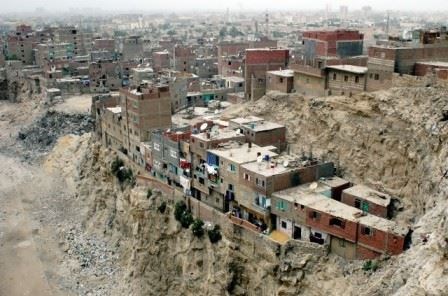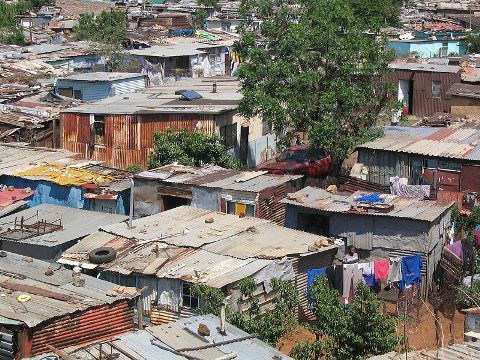 |
| The Manshiet Nasser settlement on the outskirts of Cairo. (http://bbsnews.net/bbsn_photos/topics/Middle-East/200705103_G.sized.jpg (Image Courtesy: Jeff Black/IRIN / BBS News) |
Egypt is renowned for its distinctive natural and manmade features, including the Sphinx, the great Pyramids, the Nile River, and the Sahara Desert.
The latter, though strikingly majestic in size, creates a unique challenge in terms of livable land area in a country also known as one of the most populous in Africa and the Middle East. In fact, almost the entire population of Egypt – an estimated 82 million residents– lives within 15,000 square miles near the Nile’s banks, and half of them live in urban areas, with Cairo, alone, hosting over 15 million inhabitants.
Understandably, these urban centers are bursting at the seams, and sadly, in a region once known for great opulence and royal luxuries, today its cities struggle with inadequate and unaffordable housing for its residents.
In fact, within Cairo there is a particularly aptly named sector known as the City of the Dead, a four mile long cemetery that serves as both a home to the tombs of dead ancestors, and a place where people work and even reside amongst them.
While some have chosen to live there to be near their beloved, others have no alternative but to do so within a city so desperately overcrowded. Not surprisingly, in an area where housing is now considered a luxury, informal, illegal, makeshift housing has sprung up at staggering rates. It is estimated that 16 percent – that’s over 11 million! – Egyptians currently live in shanty towns.
These ‘squatters’ have come to this difficult predicament for a variety of reasons – some because they are poor transplants from rural areas, others because they were forced and in most cases, very poorly compensated, if at all, for their previous residences, by urban developers seeking to build more modern and pricier edifices, usually encouraged by government figures who want to do away with the shanty towns without regards to residents.
And yet their plight does not end there; in many cases, these unfortunate transplants are again uprooted from even their makeshift settlements, when developers decide to use that area for something else as well.
As these impoverished citizens get pushed away again and again, the environment also suffers. Given their own personal plights, their makeshift settlements are understandably neither environmentally friendly, nor planned with any type of preservation in mind.
While some NGOs have achieved a greater sense of legal permanence for some of the settlements, for the most part, the problem remains as a constant source of grief for the millions of inhumanely housed citizens, the environment, and the overall infrastructure of the nation.
 |
| Changemaker, Hany El-Miniawy (http://www.ashoka.org/node/2990) |
Hany El-Miniawy wants to put an end to this seemingly ceaseless downward spiral.
Having studied architecture at the Faculty of Fine Arts at Helwan University in Egypt, he was disheartened in seeing that Egyptian architects were learning about Western architecture and urbanization, rather than about techniques that would work within their own environment. It was then and there that he set forth on his life’s mission.
As CEO of Appropriate Development, Architecture, and Planning Technologies, his focus takes an approach brilliantly different from otherwise well-intentioned NGOs of the past.
El-Miniawy wants to help alleviate the sweltering poverty in Egypt by developing low-cost, adequate, and environmentally-friendly housing and service facilities for the poor.
El-Miniawy believes in the principles of participatory community development, wherein members of the makeshift communities take an active role in the process of creating new permanent housing– from providing input on their needs and sharing local knowledge, to contributing financially whenever possible to further their personal stake in the area, to assisting in the actual construction, in some cases, entirely.
His approach in working directly with the poor is revolutionary in its selfless simplicity. While others either ignored the poor altogether, or forcibly pushed them aside, or only created temporary or haphazard solutions, El-Miniawy is approaching the problem from the inside, out.
The stretch of the solution goes far beyond the reach of providing housing. Residents, particularly youth, are trained in construction, and in how to live harmoniously with the earth, using and creating environmentally-friendly materials and practices. This exchange of knowledge is as monumental as are the buildings they are erecting.
In order to reduce the cost of housing, it is imperative to decrease dependency on imported materials that are both financially and environmentally costly, El-Miniawy focuses instead on working with local companies to foster environmentally safe practices and production and building methods.
 |
| A shanty town in Soweto, South Africa (http://upload.wikimedia.org/wikipedia/commons/4/40/Soweto_township.jpg) |
The stretch of the solution goes far beyond the reach of providing housing. Residents, particularly youth, are trained in construction, and in how to live harmoniously with the earth, using and creating environmentally-friendly materials and practices. This exchange of knowledge is as monumental as are the buildings they are erecting.
In order to reduce the cost of housing, it is imperative to decrease dependency on imported materials that are both financially and environmentally costly, El-Miniawy focuses instead on working with local companies to foster environmentally safe practices and production and building methods.
Literally returning to the roots of Egyptian construction, El-Miniawy has also renewed the use of ingredients and materials used by ancient builders. These materials are environmentally friendly and low cost, as well as thoroughly tested to withstand environmental conditions. His building techniques are also a faster and easier than other currently used practices.
Not all Egyptian shanty towns are made of sheet metal or cardboard or cloth– some have homes built with concrete or adobe, albeit typically in modest one or two room structures.
In fact, in cases where new buildings are not erected, residents of squatter communities are also able to update and improve their current homes with their new-found knowledge.
For communities without electricity, power, sewage, or local services, the improvements can mean much more than comfort from their inhumane conditions– they can mean an increase in health and life-expectancy.
Superficially it would appear that Il-Miniawy’s plan would serve as a perfect solution on all fronts to Egypt’s housing crisis. Instead, he has faced an uphill battle from the beginning.
For starters, state officials and powerful business people have been profiting from the import of building materials, and expectedly, convincing them that the use of local, organic materials was a better solution was not an easy feat.
Yet Il-Miniawy pressed forward with his work, and soon enough, his projects spoke for themselves.
Today, he has the support of both Egyptian society and government, and his work has been recognized internationally. He has received a number of prestigious awards, including the Tech Awards which honor those using technology to benefit humanity.
Yet as one man he can only do so much, and likewise, the ultimate resolution of Egypt’s vast housing crisis will lie in the hands of the youth he has trained. Until then, Il-Miniawy continues tirelessly on his mission.
Page created on 7/20/2012 1:23:35 PM
Last edited 8/12/2018 10:55:59 PM
